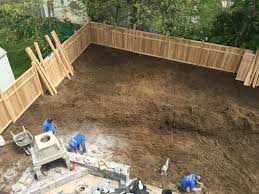How Much Does It Cost To Level A Yard?
Last Updated on September 19, 2024
Written by CPA Alec Pow | Content Reviewed by ![]() CFA Alexander Popinker
CFA Alexander Popinker
If your property suffers from frustratingly uneven terrain, holes, humps, bumps or improper drainage slopes, thoroughly leveling and grading the yard area provides an attractive, functional outdoor space.
Careful land grading prevents ongoing issues with yard erosion, flooding, foundational subsidence, and trip hazards while also preparing the leveled ground for laying decorative pavers, constructing patios or sheds, and establishing lush grassy areas. Completing major regrading and leveling projects does require a substantial investment, but the lasting benefits for your property’s health, safety and usability make the cost outlay well justified.
How Much Does It Cost To Level A Yard?
The cost to level a yard average around $1,500 to $6,000+ to professionally level or regrade, depending on influencing cost factors like total size requiring rework, slope severity, prevalent soil quality, integration steps with existing landscaping, and desired enhancements like drainage improvements.
- Land Grading Site Evaluation and Project Quoting– $200 to $500 for an expert site inspection and detailed quote providing all necessary equipment, materials, and manpower to complete the job.
- Mobilization Fees– $150 to $500 for transporting all required equipment such as bulldozers, excavators, compactors and other implements to your property at the start.
- Professional Grader or Contractor Labor– $50 to $150 per hour with total hours depending on the scope of work. Could range from 10 hours to over 100+ hours for acres of land.
- Specialized Earth Grading Equipment Rental– $300 to $1,500 per day depending on how many pieces are required for your terrain. Operators are often included.
- Imported Landscaping Materials– $500 to $5,000+ for delivery of any fill dirt, high quality topsoil, gravel, or drainage aggregates required.
- Drainage, Erosion or Stability Enhancements – $2,000 to $10,000 if installing catch basins, swales, retaining walls, supports or underground French drains to maximize the grading investment.
- Post-Grading Finishing Touches– $1,000 to $5,000 if adding topsoil, sod, seeding, pathways or other integrations to complete the leveled yards with a polished finish.
Total for Average Yard Grading Project – $2,500 to $15,000+ depending heavily on all the above cost factors weighed together.
According to Bob Vila, the typical cost to level a yard ranges from $1,006 to $3,237, with a national average of $2,122. They note that factors such as yard size, slope, and the purpose of leveling (e.g., installing a driveway, fence, or pool) can significantly impact the overall cost.
HomeGuide reports that the cost to level a yard averages $500 to $5,000, depending on the project size, type, slope, and site conditions. For smaller projects like patios or pools, the cost ranges from $500 to $1,000, while leveling an entire backyard to flatten a slope can cost between $1,000 and $5,000.
HomeAdvisor provides a similar range, stating that the average cost to level or regrade a yard is $2,175, with a typical range of $1,023 to $3,340. They emphasize that the size and incline of the project are significant factors in determining the final cost.
The Spruce offers a breakdown of costs for specific projects. They estimate that leveling a yard starts at $700 and ranges up to $4,100, with an average of about $2,400. Regrading around a house costs from $850 to $3,000, with an average of approximately $1,900.
Lastly, Forbes Home discusses the cost of land leveling and yard grading, stating that the average cost ranges from $1,500 to $5,000, depending on the size of the area and the complexity of the project.
Why Homeowners Level Their Yards
Professionally leveling a yard helps holistically solve a variety of outdoor problems:
- Removes ugly uneven terrain, tripping hazards from depressions, and bumpy areas throughout the lawn that simply look unpleasant and disjointed. Produces a smooth, consistent surface.
- Fixes poor yard drainage issues that lead to flooding, soil erosion, flooded basements, structural foundation damage, and extensive insect and fungus issues resulting from excessive moisture collecting in low areas.
- Mitigates dangerous erosion problems on slopes that cause severe deterioration and loss of topsoil over time, resulting in infertile and dry areas.
- Provides the ideal flat, stable base needed before constructing or installing patios, retaining walls, sheds, fences, irrigation systems and other landscaping projects that require a level foundation to install properly over.
- Rectifies unsafe sinkholes or depressions forming that threaten injury, damage, and gradual subsidence risks.
- Allows establishing a lush, flat lawn that thrives with proper contours and drainage angles engineered through grading.
With so many benefits provided, investing in thorough grading pays dividends over time as the improved yard conditions enhance the property’s health, appearance, and functionality for years to come.
You might also like our articles about the cost of widening a driveway, removing brush, or the price of command soil.
Factors That Impact Yard Leveling Costs
Several pivotal considerations substantially impact the costs involved:
- Sheer Square Footage Requiring Rework – Larger yards with more ground area to evaluate and contour requires escalating equipment rental time, landscaping materials imported, and professional manhours expended performing proper grading techniques.
- Slope Severity Across the Property – Lightly sloped lawns or terrain is exponentially cheaper to rework compared to hilly yards with substantial multi-level elevation changes that require extensive cut and fill reshaping work to flatten and level.
- Soil Composition and Quality – Heavily compacted clay or dense rocky soils prove far more challenging and time-consuming to break up and smooth out compared to loose, loamy particulate ideal for grading. Soil amendments or replacement is often needed.
- Integration of Additional Drainage Improvements – Incorporating retaining walls, drainage swales, underground French drains with catch basins and pipes entails major excavation and installation costs far exceeding basic leveling needs but provides crucial control over moisture.
- Professional Labor Expenses Based on Region – Prevailing equipment rental costs plus contractor hourly or job rates are influenced by local area supply and demand dynamics. Some areas simply have higher service business operational overhead.
- Optional Enhancement Steps – Electing to bring in fresh topsoil and sod once grading is complete adds more layers of expense but provides an integrated solution.
Carefully understanding your unique property challenges and tailored grading goals allows contractors to provide the most accurate pricing estimate ranges possible for your specific project scope.
DIY vs Hiring a Grading Contractor
 DIY Leveling Considerations:
DIY Leveling Considerations:
- Equipment rental fees add up quickly.
- Labor intensive without heavy machinery.
- Limited experience risks improper grading and drainage issues over time.
- Hand tools like shovels and rakes only work for small projects.
Hiring a Professional Grader Offers:
- Right equipment for your unique terrain challenges. Grading implements allow precisely contouring yards for proper water runoff.
- Saves labor time and intensive physical work.
- Experienced grading knowledge prevents future drainage problems.
- Ability to handle large yard areas efficiently.
Unless you operate heavy equipment regularly, a professional grader is highly recommended for most leveling projects beyond very minor landscaping needs.
Techniques Used to Level and Grade Yards
Cut and Fill – Strategically excavating soil from high areas on the property and relocating it through spreading and compaction to fill in any lower elevation spots as needed to produce a flat grade.
Topsoil Import – Having quality, screened topsoil or sandy loam brought in by the truckload to raise grade in low lying areas to match surrounding elevation points on site.
Subsurface Drainage Integration – Installing French drains, catch basins, solid underground drainage pipes, and gravel to divert away subsurface water from pooling in low spots.
Slope Stabilization – Building retaining walls or adding erosion control blankets and mats secured by stakes to stabilize newly graded slopes and prevent erosion issues.
Finish Grading and Compaction – Using a vibratory roller to pack down all recently backfilled or graded soil areas to 90-95% maximal density for stability.
Re-vegetating and Finalizing – Through key steps like laying sod, hydroseeding, installing decorative stones, or mulching to put the finishing touches on a pristine graded yard ready for use and enjoyment.
Signs Your Yard Needs Leveling
- Large visible lumps, holes or uneven terrain in lawn areas
- Constant drainage or pooling issues along the property after rain
- Foundation damage or shifts from improper slopes against structures
- Plans for major landscaping projects like patios needing a flat base
- Soil erosion visible on banks or hills causing property deterioration
Addressing these warning signs through quality grading prevents further yard damage and improves functionality.
Final Words
Although leveling and regrading costs understandably give some homeowners pause, averaging between $1,500 to $15,000 for most residential properties, the tangible benefits provided in terms of optimized drainage, erosion control, hazard removal, foundation protection and aesthetic uniformity make taking action a wise long-term investment.
Transforming unusable slopes and bumpy terrain into a cohesive level surface pays dividends for years beyond initial costs. Just be certain to hire grading contractors with extensive experience assessing drainage needs and properly contouring landscapes to your specifications. Choosing the right professionals who understand local soils makes or breaks the project.
Answers to Common Questions
How much work is it to level a yard?
Completely leveling and regrading a yard by hand requires extremely strenuous physical labor, possible digging or trenching, and repeatedly raking and moving heavy soil and dirt to fill uneven spots. Most homeowners hire machinery and contractors to complete significant leveling work unless only minor smoothing is needed.
How long does it take to level a backyard?
For a medium half-acre yard with moderate slopes, a professional land grading company often takes 1-3 days to fully assess grading needs, excavate high points, fill in low spots, ensure proper slope drainage angles, and complete compaction and contouring of the leveled soil.
Can you level a yard without digging?
While minor smoothing and filling of small bumps and holes can be done hand shoveling and raking topsoil, effectively leveling and grading a whole yard typically requires mechanical excavation, soil shifting, and backfill compaction to prevent future drainage issues and instability long-term.

Leave a Reply
Want to join the discussion?Feel free to contribute!